The College Years
Like most wide-eyed freshmen, Earl Campbell arrived at the University of Texas with mixed emotions. He was excited about his decision to become a Longhorn, his academic and athletic future at UT and the growing opportunity to meet new people. After all, Earl had rarely traveled beyond the outskirts of Tyler, the small East Texas town he had grown up in his entire life. Thus, Earl was also apprehensive as he walked across the beautiful yet extremely large and overwhelming campus. Earl arrived on the 357-acre campus with only one pair of jeans, a couple of T-shirts, one suit that his high school sweetheart and future wife, Reuna, had sewn for him and only forty dollars in his pocket.
Little did he or the rest of the world know, Earl Campbell, the young, fresh-faced kid from humble beginnings, was about to change the face of Texas Football and The University of Texas was about to change Earl’s life forever.
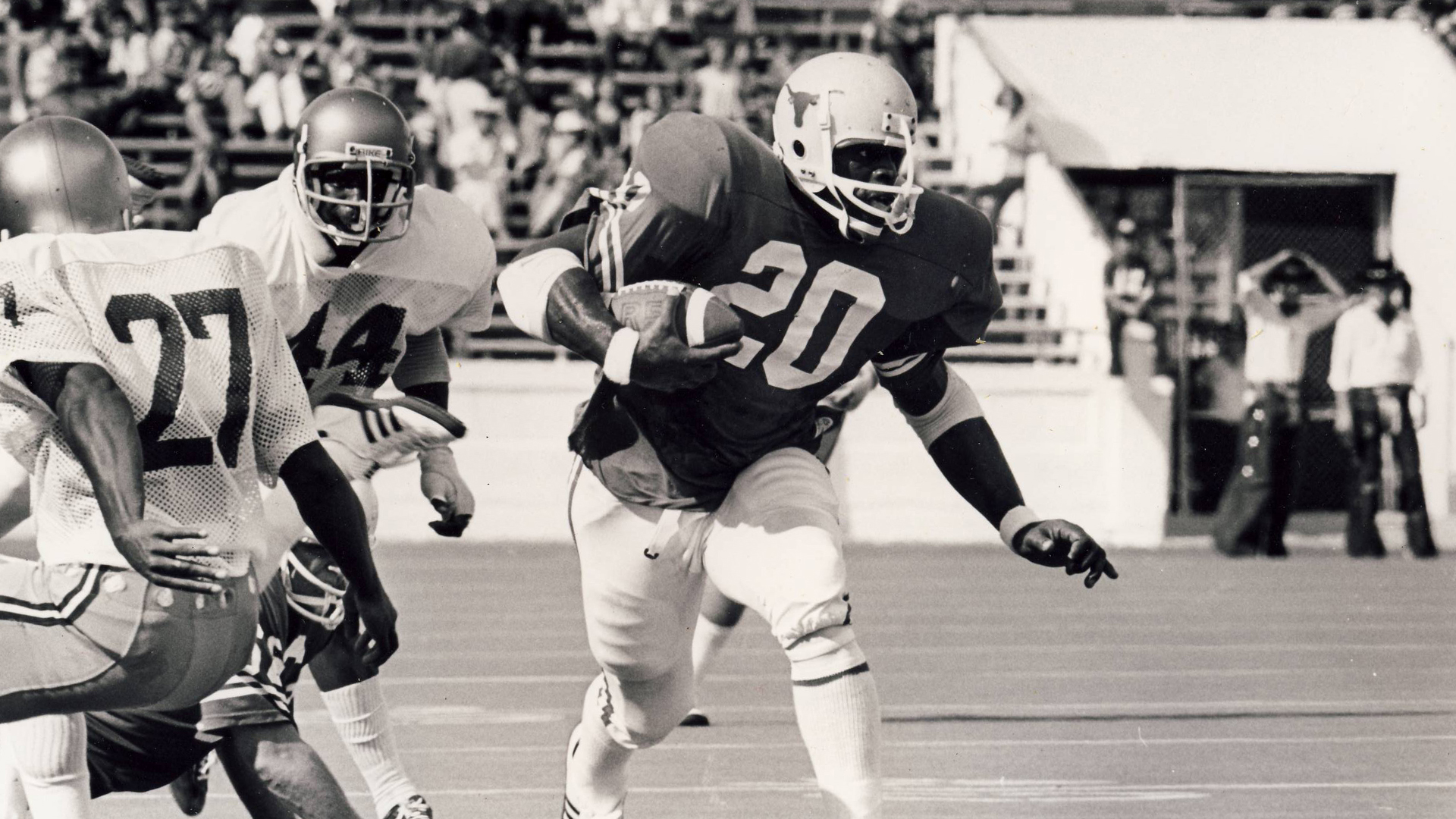
The freshman recruiting class of 1974 was considered to be one of the best crops of athletes Darrell K Royal ever recruited. The class included future stars like Campbell, Rick Ingraham, Alfred Jackson and the future Outland Trophy Winner, Brad Shearer. They were led by an outstanding team of veterans, including Earl’s player host on his official visit, Raymond Clayborn, and his new friend, Roosevelt Leaks. These young men were looked upon to be the future of Texas Football and restore the dynasty back to greatness. After all, in the eleven years prior to Earl’s arrival, Texas had won three national championships – in 1963, 1969 and 1970. The expectations were high for the entire team – on the football field and in the classroom.
Academics were very important to Earl. Not only did he attend every class on his schedule, but he also sat in the front row, directly in front of the teacher. He felt it was a privilege to be granted the opportunity to walk away from Texas with a degree in hand.
The 1974 football season provided a year of firsts for Earl: his first home game, touchdown, loss, OU rivalry, hundred-yard game and battle against Texas A&M. His first collegiate game was at Boston College on September 14, 1974. Although Earl was understandably nervous, he didn’t show it on the field, rushing for 85 yards on 13 carries and leading his Horns to a 42-19 victory over their host from Massachusetts.
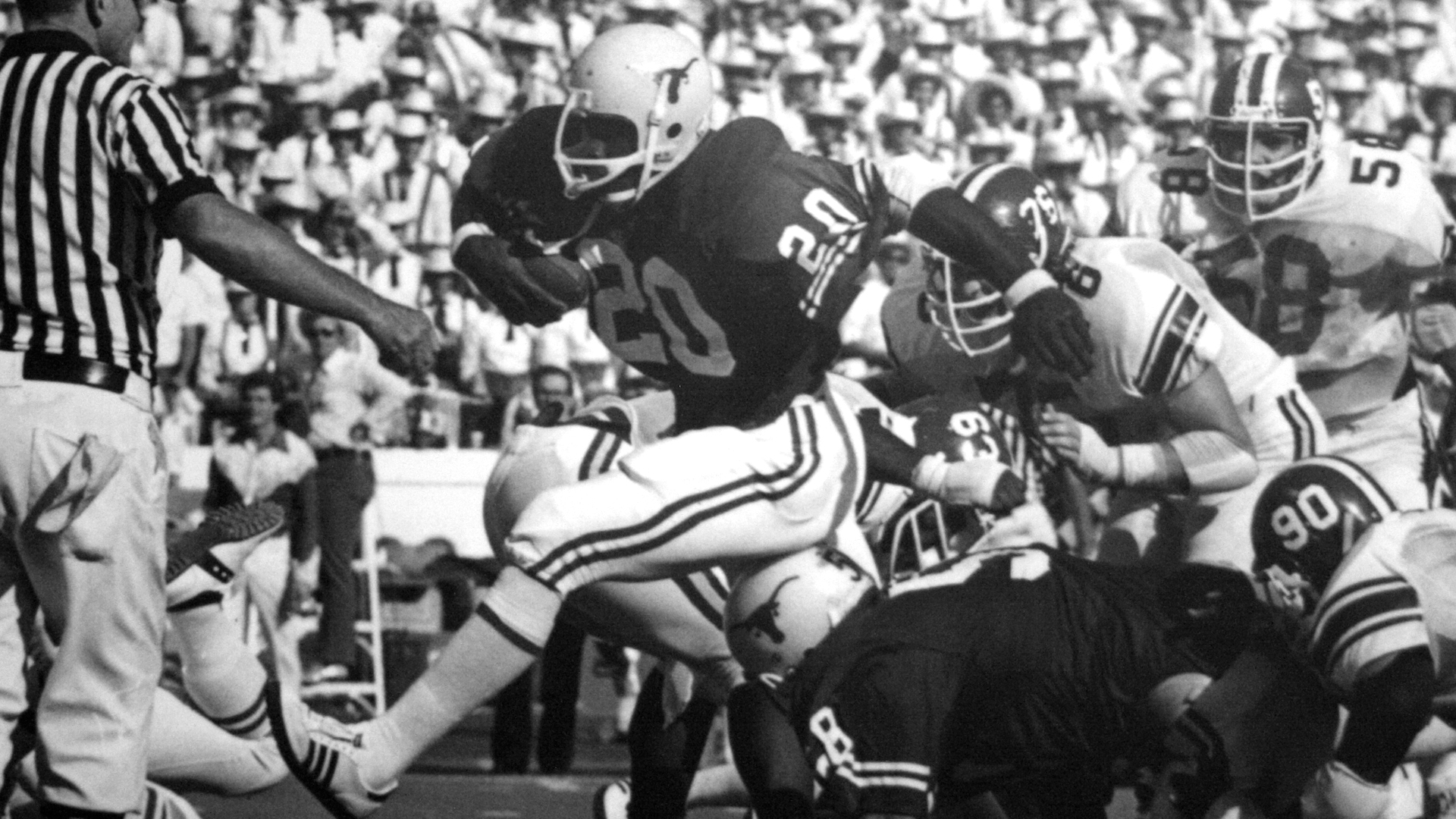
The Boston College game was an important ice-breaker for Earl, but nothing could have prepared him for the experience of his first home game at Memorial Stadium in front of over 75,000 screaming fans sporting burnt orange and white. His team mentors, Clayborn and Leaks, tried to prepare him for the dazed excitement they knew he would feel, but as Earl rushed out to take the field, he couldn’t believe his eyes. He never imagined the Texas fans would ever fill the large stadium and couldn’t believe how loud they were screaming. His nervous energy quickly turned to on-field domination, however, as the young freshman rushed for 85 yards and his first collegiate touchdown, leading his team to a 34-7 victory over Wyoming. His first home game in a Longhorn uniform was a complete athletic success.
With his impressive freshman year performance, racking up 928 yards rushing in the regular season, Earl received the Southwest Conference Newcomer of the Year Award. More importantly, however, Earl successfully passed all of his classes that year and declared Speech Communications as his major.
However, during his freshman year, he found himself becoming extremely homesick, missing his family and friends back home in Tyler.
Thankfully, the next year brought the addition of his twin brothers, Tim and Steve, to the Longhorn football family at the beginning of the 1975 season. Earl was excited about having family close to him in Austin. He also established a familial relationship with his coach and mentor, Darrell Royal. He often visited Royal and his wife, Edith, at home and also became very close with their personal friends, especially Ernest and Joyce Owens who owned a customized Longhorn Trailways bus that provided a great place for their friends to tailgate in before and after football games. The importance of friends and family, which was a value instilled in Earl at a young age by his mother and best friend, Ann Campbell, was always so important to Earl. Ann extended that family bond to the Royal family as well. She would often write Coach Royal letters of encouragement during the season, promising that she would always keep Royal in her prayers.
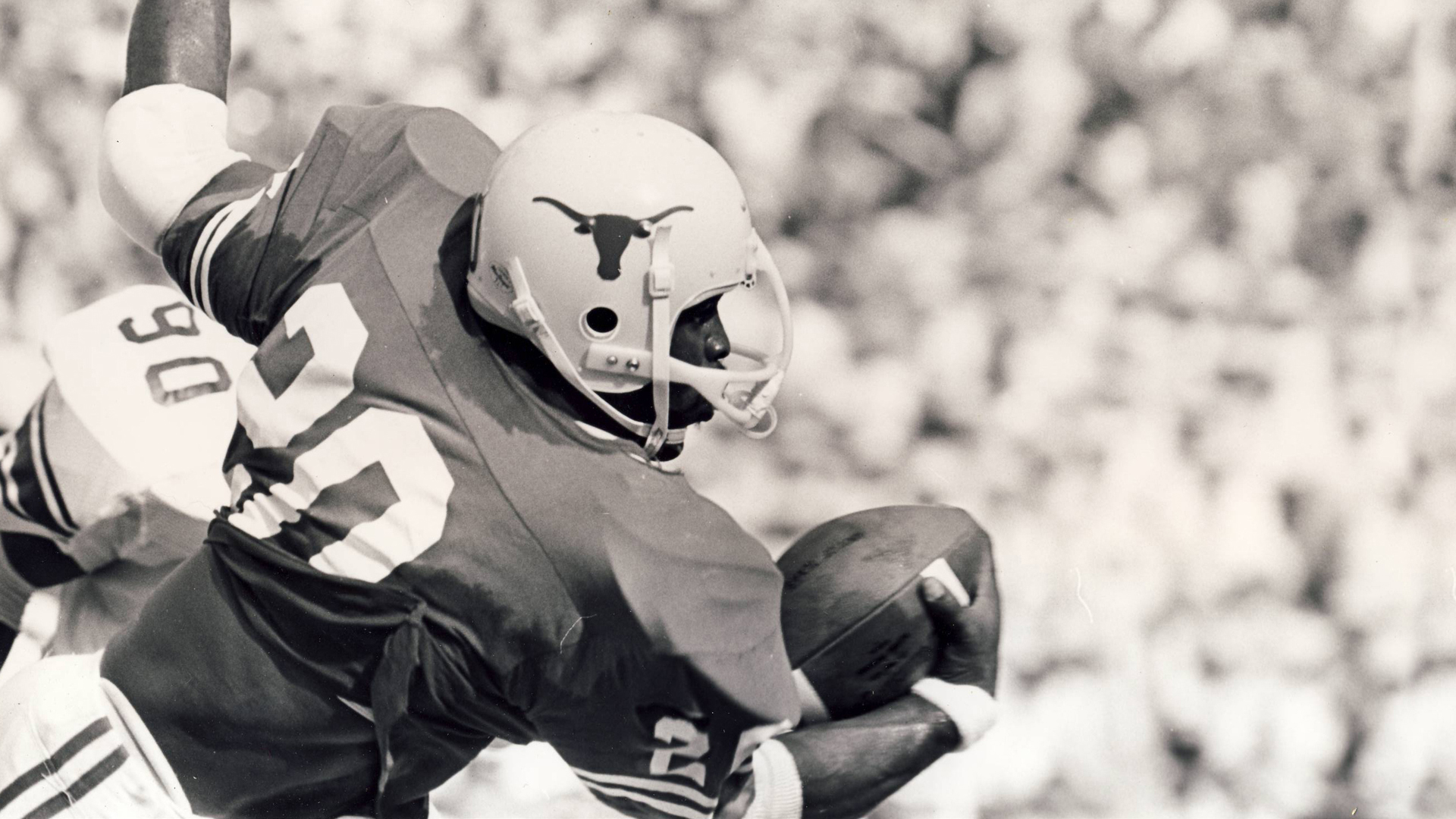
The Horns finished the 1975 season with an impressive 11-2 record, including a win over Colorado in the Bluebonnet Bowl. Earl was voted the Bluebonnet Offensive Player of the Game Award, while his freshman brother, Tim, was named the Defensive Player of the Game. Earl was also named to the All-Southwest Conference and All-American teams, and he achieved his goal of rushing for over 1,000 yards in a single season.
While the 1975 season brought an extreme amount of personal and athletic success to Earl’s life, his junior year was quite a different story. During summer practice, Earl took a pitchout from the quarterback, cut outside and began running up the field. He was stopped short of his destination but not by his tough defensive teammates. Earl heard a pop in his leg that sent him crashing to the grass. In his many years of playing football, he had never felt the kind of pain he was experiencing during that moment. The unstoppable Tyler Rose had torn a hamstring. Unfortunately, there are no immediate remedies for this injury. Earl had to accept this and begin to prepare for a long season of recovery. Although he was advised by the team doctors to rest and recover his leg for the first game, Earl was determined not to disappoint his team, the fans or himself. However, with the injury, Earl rushed for only 23 yards on five carries, and the Horns suffered a tough defeat, 14-13, at the hands of a lesser Boston College team. The following week, Earl and the Longhorns experienced one of their most embarrassing losses ever when they let North Texas State defeat them, 17-14. Although still in severe pain from his hamstring tear, Earl reeled out one of his best games against North Texas State, racking up 208 yards on 32 carries and even scoring one touchdown. But it would not be enough on this day.
The remainder of the season continued to be a series of ups and downs. The Horns finished the season 5-5-1 and in fifth place in the Southwest Conference. This included a hard-fought battle against Oklahoma that ended in a 6-6 tie, a tough loss against arch-rival Texas A&M at home in Memorial Stadium and a rewarding victory against Arkansas, 29-12, a game in which Earl gave an unyielding effort, amassing 131 yards and two touchdowns. But that final, satisfying victory proved bittersweet, as the Horns finished their worst season since 1956, the year before Darrell Royal become head coach of the Texas Longhorns.
Throughout the season, Coach Royal suffered severe criticism at the hands of a fickle media. Only one year prior, they were singing his praises, but this year was a different story. The members of the media began to doubt Royal’s decision-making capabilities and questioned his age and ability to relate to his young players. This constant abuse prompted Earl to respond, “I don’t pay attention to what ya’ll are saying, ’cause I was always taught by my parents to respect my elders, and I’m gonna do just that. My job is to do what I’m told and play football. That’s the least I can do for Coach Royal, since he’s the one responsible for me being where I’m at today.” But despite the support and respect Coach Royal received from his players and fans, including Earl, Royal knew it was time to step down as Head Coach at the University of Texas.
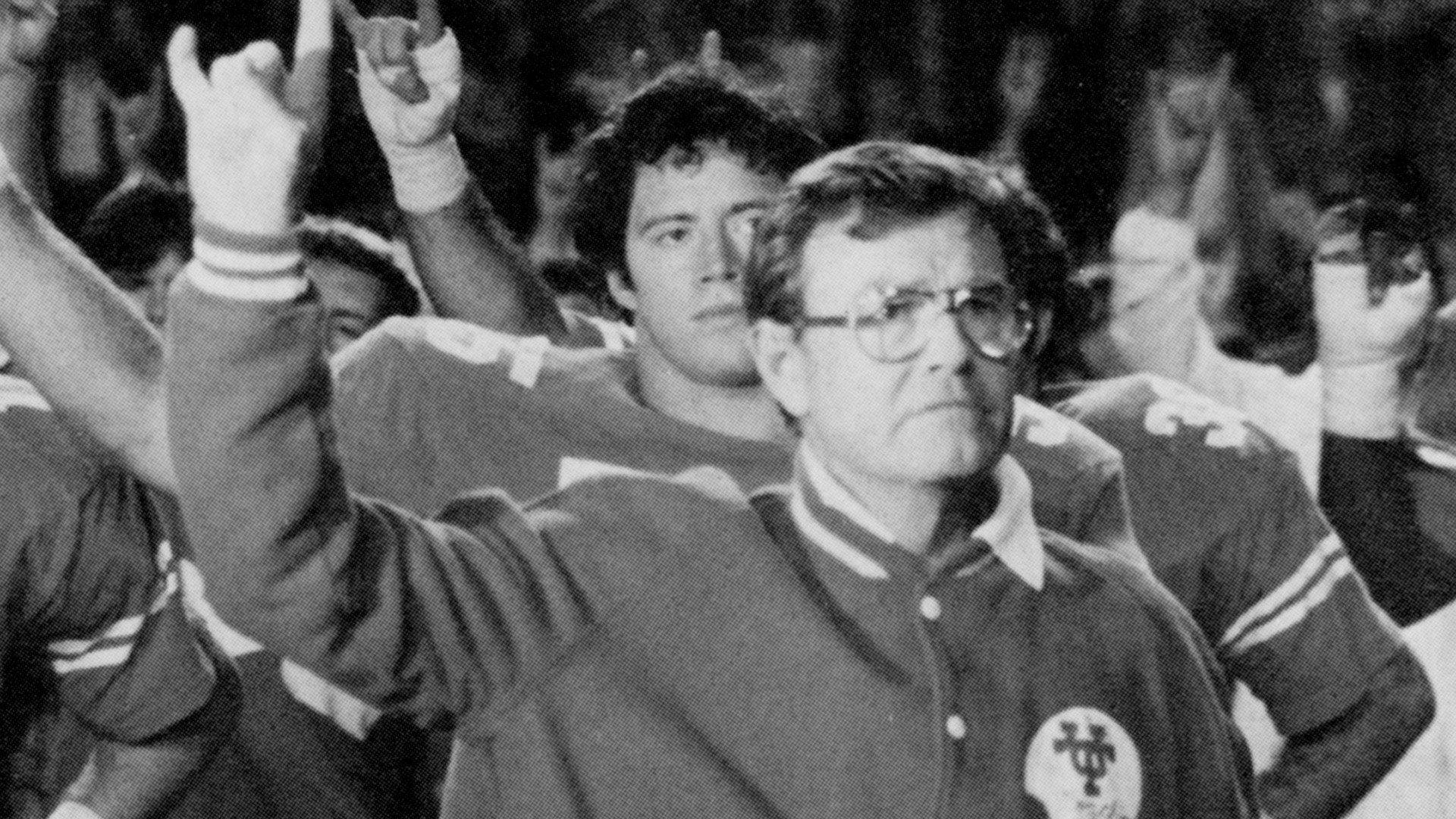
After the Arkansas win, Earl stood in the back of the locker room on a folding chair, listening as his mentor, friend and beloved coach addressed the “changing times” in the sport and admitted that the hardest part about leaving the program would be saying goodbye to all his players and assistant coaches, including “Earl Campbell, who is definitely in a league of his own.” To this day, Royal reflects on that day, fondly recalling that Earl was the only player who stayed during his entire retirement announcement. Earl was devastated by the thought of playing for any other coach than the one he considered to be the best coach in the history of the game, Coach Darrell Royal. That night, as he was leaving the stadium, he saw two men who he had never met before, hugging each other goodbye and saying, “I love you.” Earl had never witnessed two males openly expressing their feelings for one another. This prompted Earl to find the Owens’ Trailways bus. He knew he would find Coach Royal there with his friends. He entered the bus, walked over to Royal, explained what he had just witnessed and said, “This touched me ’cause I didn’t know what I was gonna say to you tonight, in the event I saw you. Anyway, I just want you to know that no matter what happens, I’ll always love you.”
To this day, Royal describes Earl as, “a loyal, caring friend. When Earl Campbell takes someone as a friend, there’s nothing he wouldn’t do for them.”
Earl’s senior year, the 1977 football season would test his determination, strength, willpower and faith in God. After being hired as Royal’s successor, Fred Akers, decided to meet with every football player on the team, including Earl. One day, after the two men had finished taking pictures for the media guide, Akers asked Earl to step into his office.
He asked Earl if he “wanted to run the ball at this university.” Earl, of course, answered that he did. Akers went on to explain that he wanted to change the offense from a wishbone attack to a straight back formation and desired Earl to be the focal point, carrying the ball 35 to 40 times during each game. Earl was familiar with the offense from his years at John Tyler High School and told Akers that he could handle the formation.
Akers said, “Good, Mr. Campbell. You’re going to have to prove it to me, and it’s going to take an awful lot of hard work on your part. I want you down to 220 pounds by the time the season begins. That’s a key ingredient if this is going to work.”
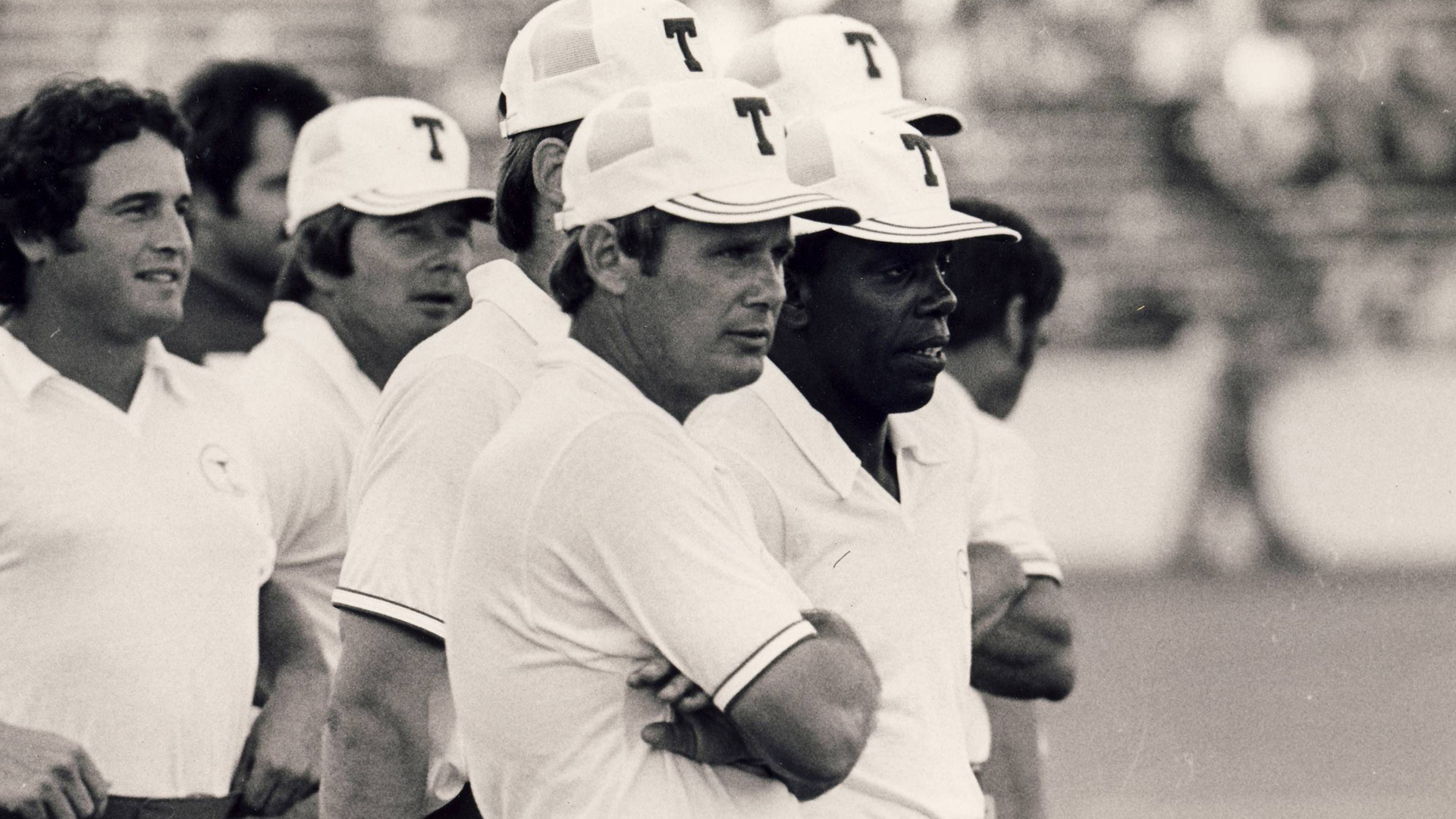
Earl was stunned. He’d weighed almost 245 pounds for several years and had no idea if he could shed that much weight in such a short period of time. But determined to make his team successful and respect Coach Akers’ wishes, Earl decided to visit Frank Medina, the Longhorns’ infamous trainer. Medina had served with two different Olympic teams and was nationally respected as one of the best athletic trainers in the world. Earl began to train with Medina every morning at 6:30 AM, pounding the heavy bag in a rubber sweat suit, running track for an hour, lifting weights and doing 400 sit-ups while wearing a weighted vest. Then it was off to the sauna for over a half-hour. He would attend his classes for a few hours and then participate in practice for the remainder of the evening. Although he thought it would be virtually impossible, Earl Campbell reported for the first home game at 220 pounds. With his hard work and determination throughout the pre-season, Earl inspired his teammates to step up their game as well. He also began to think more and more about winning the Heisman Trophy, awarded to the best collegiate athlete in the country.
After opening the season with a 44-0 thrashing of Boston College at home, the Horns went on to defeat their next two opponents, Virginia and Rice, with a combined score of 140-15. Although they were clearly on a roll, the sportswriters continued to doubt the Horns because they had not beaten any tough teams. The first real test would be the annual Texas vs. Oklahoma rivalry. After two starting Texas quarterbacks went down in the first half, Randy McEachern, who had always worked out mainly with the practice squad, was forced to step in at signal caller. This opened the door for Earl, in a way, as the team was now dependent on their running game. One of the most exciting plays of the game would also be the infamous run that would thrust Earl into the national “Heisman Hype.” After the handoff, Earl cut right and saw a dead end. He then reversed, hurdled an Oklahoma defensive player and exploded down the field for a 25-yard touchdown score.
After that run and Earl’s first ever win against arch-rival Oklahoma, Earl found himself at the top of his game and truly in a position to bring the first-ever Heisman Trophy home to Texas. The next week, Earl rushed for 188 yards on 354 carries, as the nation watched the Horns defeat the Arkansas Razorbacks. But, that week, Earl also displayed his receiving abilities. Taking a pass from quarterback McEachern, Earl dashed down the sideline, dodged Razorback defenders and bulldozed a defensive back in the process. The referee called Earl down at the one-yard line, but that play convinced sports fans all across the country that Earl Campbell was one of the most outstanding all-around athletes in the country.
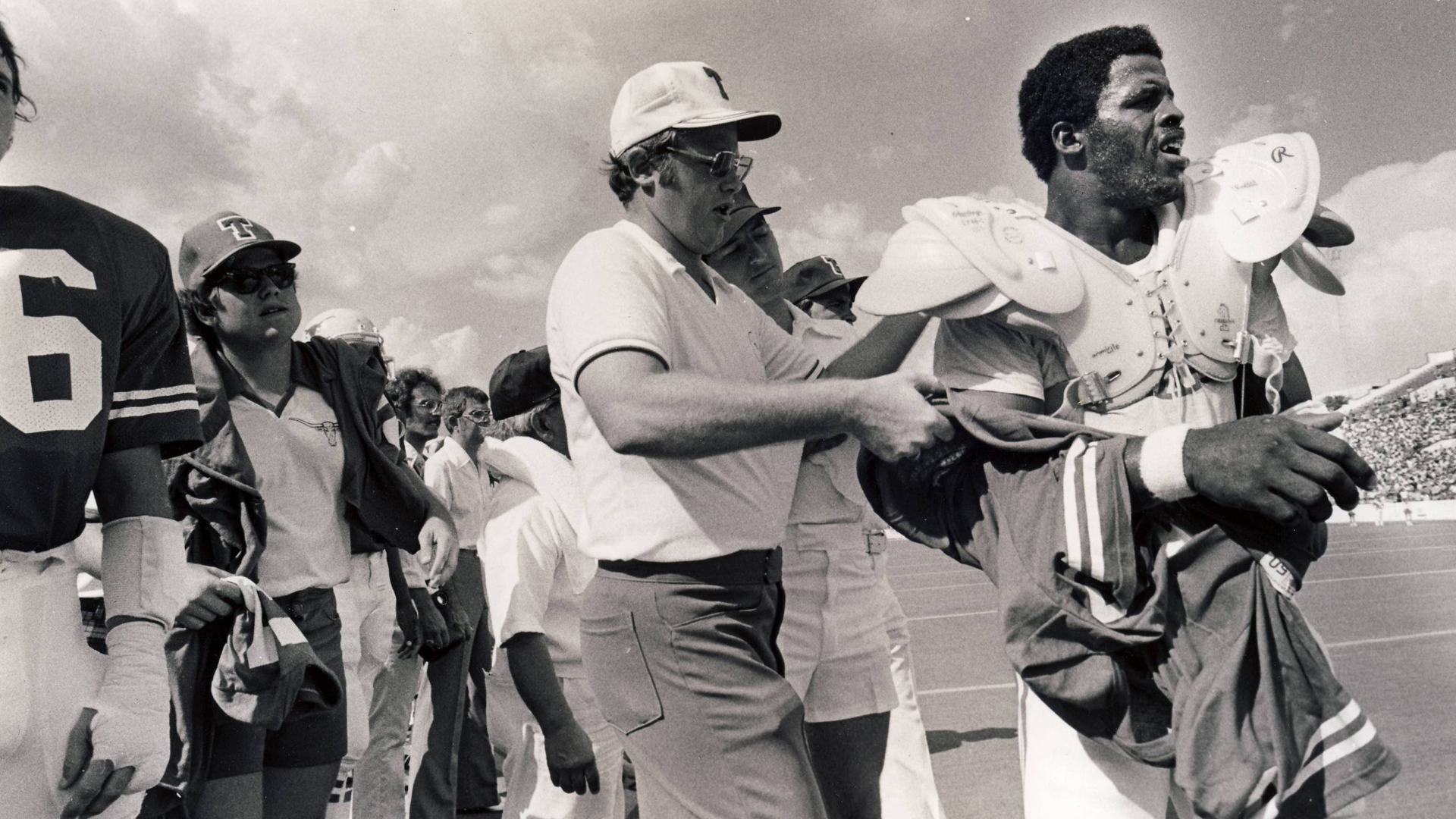 The Longhorns won their next two games against SMU and Texas Tech. Ranked number one in the country, they were determined to prove to everyone that they were the team to beat. Earl, too, was not about to let anything stand in his way…not even the flu! The night before their next match-up against the Houston Cougars, Earl complained of a stomach ache and a fever. With a 104-degree fever, Earl was put to bed, where he spent the night shivering and sweating. The next morning, although his fever had lowered to 101, the team doctor insisted that he not play in the afternoon game. But Earl had come so far in his life and beaten the odds before. He had overcome poverty at a young age, hatred and racism in his schools, the heartache of losing his father when he was only eleven and, of course, his hamstring injury the previous year. He wasn’t about to let a little flu bug stop him from playing in this game. Earl ran for 173 yards on 24 carries that day, scoring three touchdowns in the process. On his second touchdown run, as many longtime UT fans will remember, Earl barreled through the back of the end zone, knocking a standing Longhorn named Bevo, the team mascot, completely off his feet. His performance in the Houston game prompted Akers to say, “Earl Campbell is the greatest football player I have ever seen, and Ann Campbell is the best coach there ever was!”
The Longhorns won their next two games against SMU and Texas Tech. Ranked number one in the country, they were determined to prove to everyone that they were the team to beat. Earl, too, was not about to let anything stand in his way…not even the flu! The night before their next match-up against the Houston Cougars, Earl complained of a stomach ache and a fever. With a 104-degree fever, Earl was put to bed, where he spent the night shivering and sweating. The next morning, although his fever had lowered to 101, the team doctor insisted that he not play in the afternoon game. But Earl had come so far in his life and beaten the odds before. He had overcome poverty at a young age, hatred and racism in his schools, the heartache of losing his father when he was only eleven and, of course, his hamstring injury the previous year. He wasn’t about to let a little flu bug stop him from playing in this game. Earl ran for 173 yards on 24 carries that day, scoring three touchdowns in the process. On his second touchdown run, as many longtime UT fans will remember, Earl barreled through the back of the end zone, knocking a standing Longhorn named Bevo, the team mascot, completely off his feet. His performance in the Houston game prompted Akers to say, “Earl Campbell is the greatest football player I have ever seen, and Ann Campbell is the best coach there ever was!”
With the next two games, wins over TCU and Baylor, under their belts, it was now time to turn focus to the annual Thanksgiving Day battle between A&M and Texas. With the game being televised nationally, Earl knew he had to have a solid game against the Aggies vicious defense if he wanted to have a shot at winning the Heisman. Akers pulled him over before the game and said, “You get out there and get me anything over 150 yards rushing…if you do this, I feel certain that the award will be yours.” Akers, of course, could not guarantee his promise, but Earl respected the coach and did not want to disappoint him. And so Earl rushed for over 220 yards that day and led his Horns in defeating their most hated rivals, the Aggies, 57-28.
